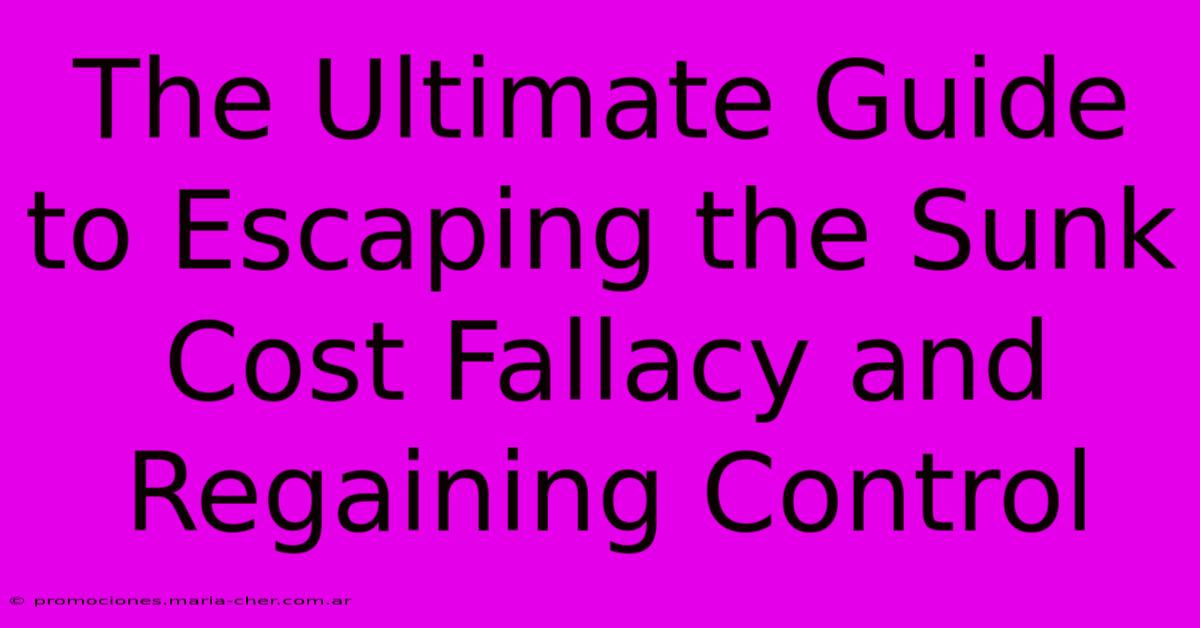The Ultimate Guide To Escaping The Sunk Cost Fallacy And Regaining Control

Table of Contents
The Ultimate Guide to Escaping the Sunk Cost Fallacy and Regaining Control
We've all been there. Stuck in a situation, pouring more time, money, or effort into something that's clearly not working. Why? Because we've already invested so much. This is the sunk cost fallacy, and it's a powerful psychological trap that can sabotage our happiness, finances, and even our careers. This ultimate guide will help you recognize, understand, and ultimately escape this debilitating mindset, regaining control of your life and decisions.
Understanding the Sunk Cost Fallacy
The sunk cost fallacy is the tendency to continue investing in something – be it time, money, or effort – simply because we've already invested in it, regardless of whether continuing is rational or beneficial. We irrationally justify further commitment based on past investments, even when the future prospects are bleak.
Think about it:
- The failing business: You've poured your savings into a startup that's consistently losing money. Instead of cutting your losses and moving on, you keep investing, hoping for a turnaround that's increasingly unlikely.
- The tedious project: You've already spent weeks on a project that's now proving to be far more complicated than anticipated. Rather than abandoning it and starting fresh, you push on, feeling obligated to finish, despite the diminishing returns.
- The unsatisfying relationship: You've been in a relationship for years, despite a lack of happiness or compatibility. The thought of "wasting" all that time keeps you from moving on.
These are all examples of the sunk cost fallacy in action. The key is understanding that past investments are irrelevant to future decisions.
The Psychology Behind It
The sunk cost fallacy stems from several psychological factors:
- Loss aversion: We feel the pain of loss more strongly than the pleasure of gain. Cutting our losses feels worse than accepting the initial investment as a sunk cost.
- Cognitive dissonance: We strive for consistency in our beliefs and actions. Admitting a past investment was a mistake creates cognitive dissonance, making it difficult to change course.
- Justification of effort: We want to believe our past efforts were worthwhile. Continuing, even when unproductive, allows us to justify those efforts and avoid feeling like we've wasted time or money.
Escaping the Sunk Cost Fallacy: Practical Strategies
Recognizing the sunk cost fallacy is the first step; escaping its grip requires conscious effort and strategic thinking. Here's how:
1. Identify Your Sunk Costs
Start by honestly assessing where you're experiencing the sunk cost fallacy. What are you investing in despite negative returns? Be specific: List the time, money, and effort already invested. This act of acknowledging the sunk costs can help you detach emotionally.
2. Separate Past from Future
Remind yourself that past decisions are immutable. You can't change what's already happened. Focus exclusively on the future and what will maximize your well-being and achieve your goals. What's the best course of action now, regardless of what happened before?
3. Analyze the Current Situation Objectively
Evaluate the current situation without the emotional baggage of past investments. Are the future prospects positive? Is there a reasonable chance of a positive return on further investment? Be brutally honest in your assessment.
4. Calculate the Opportunity Cost
Consider what you could gain by redirecting your resources (time, money, effort) elsewhere. What other opportunities are you missing out on by clinging to a failing venture? This can be a powerful motivator for change.
5. Set a Stop-Loss Point
Before committing further resources, set a clear stop-loss point. This is the point at which you'll definitively cut your losses and move on, regardless of your sunk costs. Having this predetermined point can prevent you from drifting further into the fallacy.
6. Seek External Perspectives
Talk to trusted friends, family, or mentors who can offer objective advice. They can help you see the situation clearly, free from the emotional biases that fuel the sunk cost fallacy.
Regaining Control: Moving Forward
Escaping the sunk cost fallacy is not about admitting failure; it's about making rational decisions for a better future. It’s about acknowledging past mistakes and learning from them, without letting them dictate your future actions. By employing these strategies, you can reclaim control of your life and make choices that align with your goals and well-being. Remember, letting go of something that's not working is not a sign of weakness; it's a sign of strength and wisdom.
Keywords:
Sunk cost fallacy, sunk cost, loss aversion, cognitive dissonance, opportunity cost, decision-making, regret avoidance, rational decision making, financial decisions, relationship decisions, career decisions, time management, resource allocation, letting go, moving on, escape sunk cost trap, regain control.

Thank you for visiting our website wich cover about The Ultimate Guide To Escaping The Sunk Cost Fallacy And Regaining Control. We hope the information provided has been useful to you. Feel free to contact us if you have any questions or need further assistance. See you next time and dont miss to bookmark.
Featured Posts
-
3 D Colorization Unlocks The Secrets Of Raw Pork Prepare To Be Amazed
Feb 06, 2025
-
Time Saving Tip How To Use A Dnd Nail Lamp For Effortless Flawless Nails
Feb 06, 2025
-
Empowering Womens Health The Ultimate Guide To Finding The Best Gynecologist
Feb 06, 2025
-
From Azure Dragons To Crimson Fiends Paint Your Nails With The Colors Of The Sword Coast
Feb 06, 2025
-
Orange Roses The Floral Messengers Of Optimism Excitement And Encouragement
Feb 06, 2025
